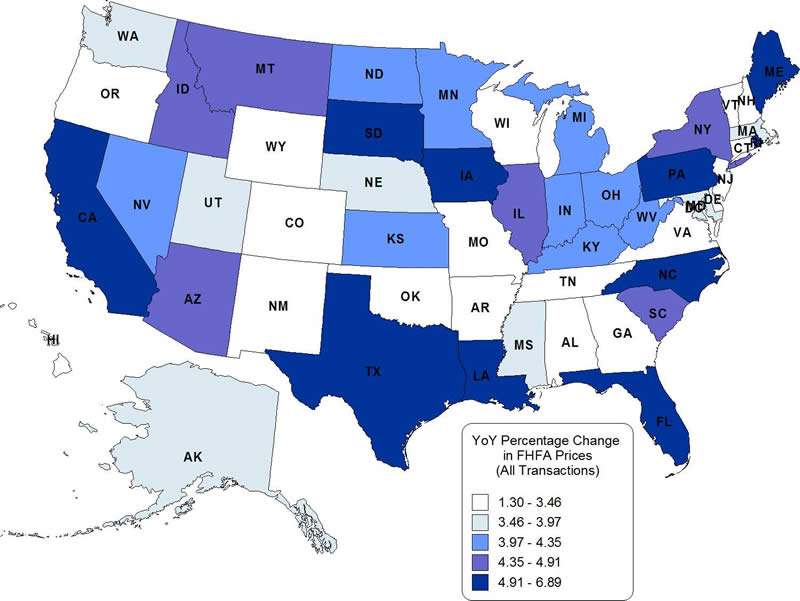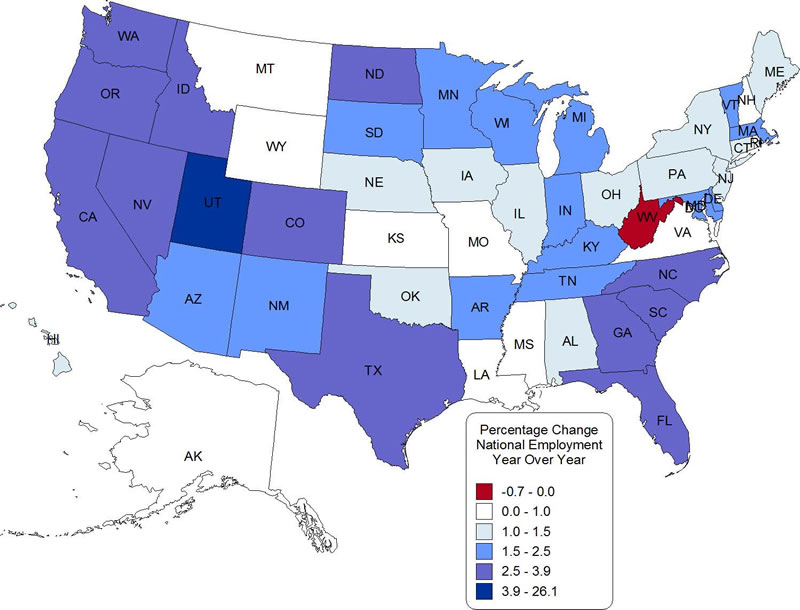By Brian Lewandowski, Associate Director, Business Research Division, Leeds School of Business
The April jobs report was released for Colorado today, with the preliminary numbers showing a month-over-month increase in employment (4,200 jobs, 0.2%) and an upward revision to the March estimates. According to data from the Colorado Department of Labor and Employment (CDLE) and the Bureau of Labor Statistics (BLS), April recorded 63,200 more jobs than the same month in 2014, increasing 2.6% year-over-year. The pace of growth is slowing in Colorado according to the preliminary April numbers—after growing in excess of 3% for 16 consecutive months, March and April slowed to 2.8% and 2.6% year-over-year growth, respectively. Year-over-year growth in April ranked Colorado 11th nationally, and monthly growth ranked the state 27th. Average weekly wages increased year-over-year for each quarter in 2014 (4.2%, 3.2%, 3.1%, and 2.9%, respectively) based on data from the CDLE. State per capita personal income increased 3.9% in 2014 to rank 14th nationally, and quarterly personal income rose 5.9% year-over-year in Q4 2014.
Colorado employment grew year-over-year in all of Colorado’s metropolitan statistical areas (MSAs), while monthly growth decreased in four MSAs. Industry growth was recorded in 10 of the 11 industries in the state year-over-year, but growth was only recorded in six industries month-over-month. The velocity of growth slowed in eight industries.
The greatest year-over-year percentage gains were in Construction (9.8%), Mining and Logging (5.5%), and Education and Health Services (4.9%). The weakest sectors for growth included Information (-3.9%); Professional and Business Services (0.8%); and Trade, Transportation, and Utilities (1.3%). Compared to March, the strongest month-over-month growth came from Other Services, Leisure and Hospitality, and Construction; the weakest was in Mining and Logging, Information, and Financial Activities. However, the Colorado Department of Labor and Employment expressed anticipated revisions based on newly released Q4 QCEW data:
Industry sectors expected to undergo the greatest upward revisions to payroll jobs estimates in the 4th quarter include government, trade, transportation and utilities, professional and business services and other services. Jobs in mining and logging, information, financial activities and education and health services may also be revised up.
-State Labor Department Releases Analysis of Fourth Quarter 2014 Economic Data, May 27, 2015.
According to the release of the Q4 2014 Quarterly Census of Employment and Wages data, the state of Colorado added 81,983 jobs from 2013 to 2014, representing a 4% increase in total employment. The industry with the biggest percent increase was Mining Support Activities, which recorded 21% growth over the period (3,225 jobs). Construction and its related industries also showed marked growth year-over-year: Construction grew 11% and added 14,543 jobs, Specialty Trade Contractors grew 11% with 9,207 added jobs, and Heavy and Civil Engineering also grew by 11% with 2,225 jobs added. While the Mining industry overall gained 3,414 jobs (11%), the Mining, Except Oil and Gas industry lost 415 (8%) jobs, indicating that growth in the industry comes exclusively from oil and gas. Total statewide wages also posted an increase in 2014; they grew by 7% over the period. Growth in wages corresponds greatly with employment growth; Mining Support Activities saw 29% growth, Construction saw 17% growth, Construction of Buildings saw 19% growth, and Specialty Trade Contractors saw 17% growth.
Growth in Colorado’s Manufacturing Sector ranked 5th nationally, with 3.2% year-over-year growth, and gained 0.3% from March to April. The Construction industry showed the greatest pace of job growth year-over-year in Colorado. The industry grew 9.8%, which leaves Colorado 15,700 construction jobs (9.7%) below the previous industry peak in 2007. Home prices increased 9.4% year-over-year in Q1 2015 according to the FHFA home price index (10.2% in the Denver-Aurora-Lakewood MSA).
FHFAHome Price Index, Q1 2015, Year-over-Year

Data Source:Federal Housing Finance Authority, All Transactions Index, Not Seasonally Adjusted.
While WTI oil spot prices began to fall in June 2014, the economic indicators remained fairly strong until early 2015. As of late-May, the WTI spot price had increased 37% from March 17, 2015, but was still down 44.9% from June 20, 2014. Average natural gas (Henry Hub) prices were down 38.5% year-over-year in May, and gasoline prices down 24.2%. The falling oil and gas prices have placed a drag on the oil and gas industry nationally and in Colorado. The Baker-Hughes rig count in Colorado was down 40.8% in May compared to the same period in 2014. Evidence of the slowing industry also shows in the employment numbers—while employment in the Mining and Logging Sector, which is dominated by oil and gas activity, was up 5.5% year-over-year in April, the sector recorded a third-consecutive month-over-month decline—the worst since November 2012. Likewise, the Greeley MSA declined for three consecutive months. Monthly drilling permits—a metric that tends to be volatile—were half what they were in April 2014. Of the 42 states with published Mining and Logging employment, only 6 states marked monthly employment growth in April, and 9 recorded year-over-year growth.
The April unemployment rate stood at 4.2% for the 5th consecutive month, ranking Colorado 14th nationally. At the low end, Nebraska and North Dakota ranked 1st and 2nd, at 2.5% and 3.1%, respectively. At the high end, Nevada and West Virginia ranked 50th and 49th, with 7.1% and 7% unemployment, respectively. Year-over-year growth (0.7%) in the Colorado labor force ranked 33rd in percentage terms in absolute growth.
When compared to other states Colorado still remains one of the best recovery states in the nation in terms of employment, ranking 4th nationally for growth above the previous peak, behind only North Dakota, Texas, and Utah. Colorado now measures 6.2% above 2008 peak employment compared to 2.2% for the nation. National job growth accelerated in April, with the United States adding 223,000 jobs compared to 85,000 in March. The three-month moving average ending in April was 191,000 compared to 248,000 a year ago.
April State Employment Growth, Year-over-Year

Data Source: Bureau of Labor Statistics, CES, Seasonally Adjusted.
The variation in growth around the state is beginning to moderate as growth rates in Southern and Western Colorado increase and the northern energy corridor slow. Year-over-year growth was recorded in all of Colorado’s MSAs: Greeley (5.6%), Denver-Aurora-Broomfield (3.2%), Grand Junction (2.5%), Fort Collins-Loveland (2.2%), Colorado Springs (2.1%), Pueblo (2%), and Boulder (1.6%).
The May national jobs report will be released June 5, 2015. The May state jobs report will be released June 19, 2015.